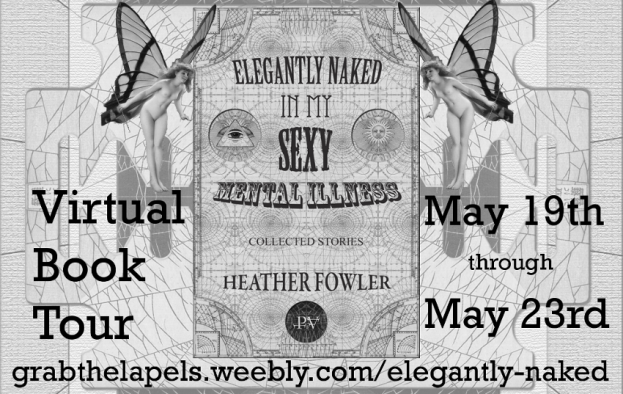Heather is here as a stop on her Virtual Blog Tour to answer interview questions regarding how she generates her wildly different stories and the role of multiple influences in her newest work. Also here in this post is an audio reading of a story set during the French revolution.
***
As an author, you create work that is both highly modern in its sensibilities and also work that has historical influences. Can you tell us what factors impact a desire to write in both realms?
Every piece of work has historical influences. For me, it simply matters whether the history is personal or a history with reading. In the latest collection, for example, there are pieces set in the French Revolution and during the time of the Italian bubonic plague. There is another story set in what I would imagine to be the1920s. These stories were driven by reading of texts that came from their time frame, literary readings. The plague piece, for example, “Mother’s Angels,” began as an inquiry into the first historical use of the marking of Jews with the fabric badges—the persecution of the Jews in Nazi Germany, and my readings done as research into how this “marking” phenomenon began. To discover that the same sort of persecution happened in the 1300s was fascinating, and I began to read all I could find on the Catholic/Jew relations during those times and circumstances, including how both the plague itself and the instances of floods, referenced in the piece, came to be blamed on Jews by anti-Semites, partially out of the sort of paranoia mass deaths caused but also out of an ugly desire for vengeance or the acquisition of wealth. Even the politician in the piece was lifted directly from historical documents. The relationship between the mother and daughter, however, was purely my imagination.
Similarly, the “Blood, Hunger, Child” piece had its start when I began reading the 1789 Declaration of the Rights of Man and the Citizen, but curiously, I was influenced to write this piece when I read of a theft of one of Marie Antoinette’s necklaces that actually took place. I was interested in the attitude of the French people toward their queen and the way she became a symbol for the gross excess of French nobility and royalty that became the causal fire behind the revolution. I was also interested in reading about the creation of the guillotine, so, in that piece, all of this reading rather blended. I even use translations of French documents in the piece when the political segments come in. The story began rather large in scope, but as I continued to edit the piece, I realized that what was truly fascinating to me was the class warfare and the idea of love in a time of horror. This is why my protagonist and her significant other starve, why the circumstances impact the resultant action and views on the world as both she and he see it.
The collection also has a piece that plays with a famous story by Flannery O’Connor, “Good Country People,” that was published in 1955. Even the sound of the language in that piece differs from others in the collection. Can you speak to that?
Flannery O’Connor is one of my favorite authors and I love the clear lens with which she writes. I wrote my pair piece “Good Country. People.” for a series at the Necessary Fiction site where authors were invited to take a part of a famous story and write a piece that the famous piece inspires. This is where personal history comes in; I had spent time in the South, did a graduate degree in Virginia. I had lived among Southerners and always had an affinity for their written work. When I got the chance to play with Flannery’s piece, I read and reread her stories, which are some of my favorites, and had a wonderful time matching her cadences but bringing my aesthetic to the work. I also enjoyed playing with the ideological concept Flannery often exploits regarding violence allowing for a moment of grace. In her original piece, a con man selling bibles leaves a handicapped girl in the loft of a barn. The story ends that way—with the girl trapped and abandoned. In my piece, I set my work just after this abandonment. Except her con-man comes into a moment of grace in my piece, with the next girl he tries to steal a prosthetic from beating him quite soundly. That piece differs because it is a love letter to O’Connor. Even the sound of the language borrows from her tradition. Only the moral of the story has an update.
Ah. But there are also stories that are quite modern in the collection. How did you decide which to include in this book?
I thought about how I like variety and novelty as a reader. This whole collection was built on two ideas—1. Does the story I want to include address the theme of mental illness, and 2. Would I love this book as a reader, feel it gave me the satisfaction of reading an anthology of sorts, which is to say feel it gave me many styles, ideas, and plots to consider? Something funny about this book in particular is that I decided to create a manuscript when I realized I’d been doing quite a bit of research on various types of mental illness but when I went to compile the first version of the manuscript, I thought I’d be using stories generated with recent research, only then to discover I’d been writing about various ideas of mental breaks/fractures for years and years. The collection houses work anywhere from fifteen years to less than two years old. But I loved the movement of piece to piece when I compiled it. I wanted the theme to be that broad and ambitious—as if the book would be a funhouse of mirrors, each mirror a different style or circumstance or time.
This collection is illustrated by a graphic artist named Pablo Vision. How did that come about?
I had been familiar with Pablo’s brilliant literary work for years since we once did a fiction marathon together a long while back and wrote thirty stories in thirty days. When he saw this book listed as in progress on my website (something my agent has now asked that I don’t list there), he wrote me asking to read it. He had also just read a post at my RedRoom blog called “The Literary Writer (Female) and Sex,” and reinitiated our conversation.
When he first wanted to see the new book, I had just participated in an art and literature project called The Better Bombshell, pairing my written work with the work of a famous photographer, so I immediately suggested that he illustrate the book if he liked it, which he rejected outright. Then he read the book, fell in love, and it was history. He created the illustrations, one by one, and within months of finishing the graphic art, we secured a risk-taking publisher for the work with Queen’s Ferry Press. This is an excellent venue for modern, innovative fiction. This book is more a book object in the European sense of the term than a normal trade paperback.
Readers may also enjoy the Artist’s Appendices we include with this collection. How he compiled this art is fascinating. It too has historical influences. Much of the art can be viewed on the trailer. This excerpt of this story is only available here.
 Listen to Heather read an excerpt from the story “Blood Hunger Child,” an intense piece of historical fiction.
Listen to Heather read an excerpt from the story “Blood Hunger Child,” an intense piece of historical fiction.
You can purchase Heather’s book here!
Heather Fowler is the author of the story collections Elegantly Naked In My Sexy Mental Illness; This Time, While We’re Awake; People with Holes; and Suspended Heart. Fowler’s work was named a 2012 finalist for Foreword Reviews Book of the Year Award in Short Fiction. She received her M.A. in English and Creative Writing from Hollins University. Her stories and poems have appeared in: PANK, Night Train, storyglossia, Surreal South, Feminist Studies, The Nervous Breakdown, and others. Please visit her website: www.heatherfowlerwrites.com
![[PANK]](https://pankmagazine.com/wp-content/themes/pank/assets/images/pank-logo-large.png)

